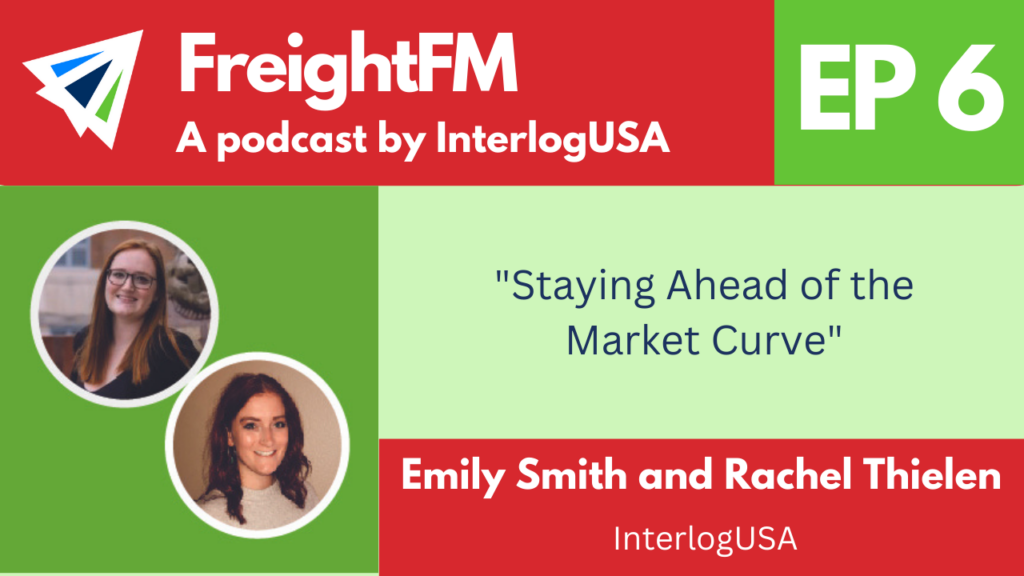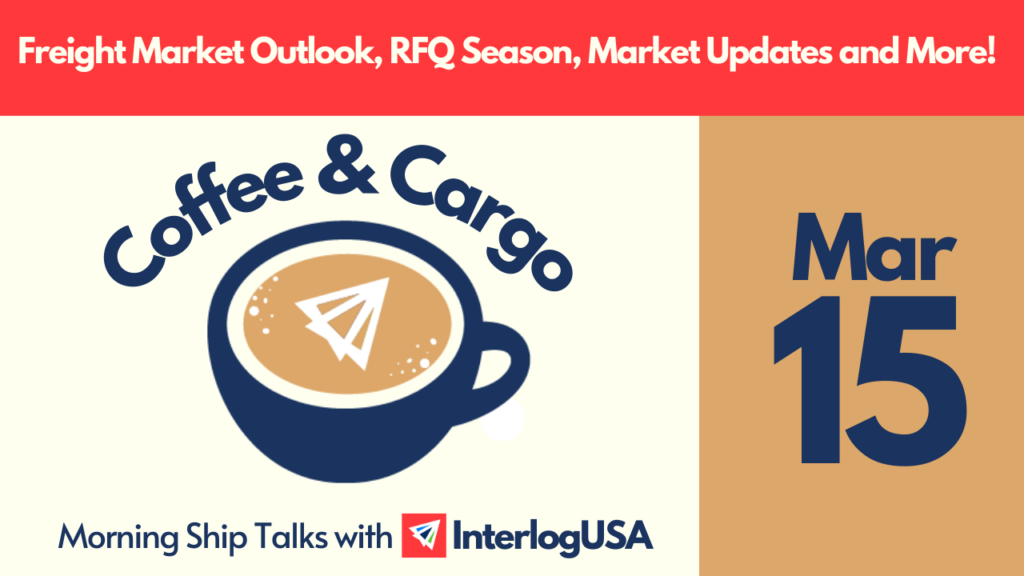Interlog  Insights
Insights
March 2023
The following is an archived collection of our weekly insights through the third month of 2023. Those who had signed up to our Interlog Insights newsletter received each week’s update to their inbox on the original release date. If you like what you see below, please feel free to sign up yourself to get these updates right as they come!
This month's insights
- "RFQ Rescue"
- West Coast Labor Contract
- Supply Chain Visibility
- Import Volumes
- 2M Termination
Week 4 - Originally released March 24
Insight: Latest Updates on West Coast Labor Talks
Terminal gate delays at the Port of Los Angeles/Long Beach have been occurring, due to recent ILWU job action. Earlier this week, the Pacific Maritime Association (PMA) said in a statement, that longshore workers, represented by Local 13 of the ILWU have, since last Wednesday “refused to stagger their meal breaks as required, [which has resulted in] periods when no work is being done on the docks.” The PMA showed the media photos which they say shows trucks backed up at the Fenix Marine Terminal at the LA port and its ITS Terminal at the LB port, last Friday. However, the ILWU International President said in a statement this past Monday that “longshore workers are continuing to work every day according to the mutually agreed terms. But that terminal operators, “open and close their gate at will.” Recap of the last three weeks At the start of March, we provided a timeline that detailed when the U.S. West Coast labor talks started, to where negotiations are currently at and if there is any outlook on when negotiations may be reached. As we moved into week two of insights, we discussed if the negotiations impacted shippers and/or trade on the U.S. Coasts, and if that shift would continue. We detailed how business overall on the USWC had dropped, especially on a year-over-year basis, but the Port of Los Angeles still remained the overall busiest U.S. port in 2022. Last week, there weren’t many updates on the talks. Though, Port of Los Angeles Executive Director Gene Seroka, who spoke at The Premier Conference (TPM23), emphasized that the majority of the 15,000 longshore workers throughout the San Pedro Bay Ports are working as normal. Everyone is eager for these negotiations to come to an end and an agreement be set in place. |
Watch our sixth episode of FreightFM! InterlogUSA’s Rachel Thielen and Emily Smith touch base on current market conditions and how to best prepare when the industry sees another shift.
Insight: Post-Alliance Strategies Continue to Reveal Themselves
Even though Maersk and MSC aren’t terminating their vessel-sharing agreement until 2025, the two ocean line giants appear to be getting a head start on their post-alliance existence. Last week, we covered some initial signs of a “pre-split” process between the two. Maersk and MSC closed one of their major 2M loops in the Asia-Europe market. While egged on by weaker freight volumes, the move is still surprising. Surprising in the sense that it’s happening. The world’s two largest carriers are actually going to split from the once gold standard of alliance formality. This service closure made 2025 feel a lot closer. Quick recap of MSC’s “pre-split” sign In wake of the stoppage, MSC flexed its capacity muscle and launched its own service instead on the Asia-Europe trade. With more megaships set to arrive this spring, the carrier is likely not waiting until 2M’s termination to keep expanding its lone wolf network. Maersk also launches Asia-Europe service by air Truly in line with Maersk’s pursuit for end-to-end supremacy, the carrier’s air freight division has begun scheduling flights to Hangzhou, China from its air hub in Billund, Denmark. Starting this week, Maersk Air Cargo will have three weekly flights which include the carrier’s newly converted Boeing B767-300 freighters. While MSC’s new service signals its dominant ocean tonnage and capacity for a standalone global network, Maersk is showing the industry that its assets don’t just wade through the water, but soar through the clouds, stow and distribute valuable cargo, and drive the speed limit all the way up to their customers’ doors. Confidence is an understatement when describing the carriers’ faith in capitalizing off their individual strategies. MSC envisions its ocean network will be vast enough to sail the seven seas, while Maersk believes it can cover all logistics bases to provide a full end-to-end customer experience. |
Week 3 - Originally released March 17
Insight: First Signs of 2M's "Pre-Split" Process
When the two ocean lines announced their soon-to-be divorce in 2025, Maersk and MSC assured stakeholders of continued cooperation up until the termination date of their 2M Alliance vessel-sharing agreement. While transitionary moves between now and then are expected to be made, the industry could be in store for an emphatic “pre-split” process between the carriers. Maersk and MSC have refrained from reinstating a loop on the Asia-Europe trade. 2M’s AE1/Shogun service will not be renewed as China’s outbound volumes continue to stutter. MSC starting standalone services ahead of 2M’s termination Aside from weak volumes, the closure of this major 2M loop comes as MSC—the world’s largest ocean line—is set to take delivery of even more megaship tonnage in April and May. The Swiss-headquartered carrier will soon be greeted by five new vessels each bolstering a 24,000 TEU capacity. Another nine vessels (each between 19,000 and 24,000 TEU) are slotted to be delivered before the end of 2022. A total of 40 megaships are in MSC’s 1.8 million TEU orderbook. Yes, ocean freight’s “king of capacity” is going to get even bigger and MSC can now sail alone. Just recently, the carrier began bearing the fruits of this strategy. MSC launched its Dragon service—a standalone loop—onto the Asia-Europe trade. The service presently calls at rate-lucrative ports in French, Italian, and Israeli markets. A few questions to ask As we said earlier, Maersk and MSC are expected to make transitionary moves between now and their partnership’s termination date, however at what pace will this occur? Is their vessel-sharing agreement—which is supposed to stay in place until January 2025—unraveling, prematurely, in front of our eyes? How will this impact quality of service and coverage of 2M’s network for the remainder of the agreement? |

NEW RFQ Rescue
The market has become more stable than it has been the last few years. However, when capacity was tight and rates started to rise at a fast rate, many companies searched for additional carriers for options to keep their freight moving. Now, our industry is seeing a shift where companies are starting to take a look at their carrier base and really evaluate who is the best fit for them. Who helped them when the chaos happened, and which carriers have excellent communication and service. Our industry is going to see an RFQ season but what does that exactly mean? Will RFQs give you full transparency on the forwarders value? How are you planning to evaluate a forwarder based off your RFQ process? Here are a couple tips from our experts as you start your RFQ process: Have a phone conversation: You can learn a lot about a company by a quick call. You will learn how they communicate with you, how they work together as a team and the way they operate that directly impacts your company. Ask them the tough questions: How does the forwarder react when things get tough? What if something goes sideways during the process and how do they handle it? You should have full transparency on how they approach situations and determine if they will do everything they can to keep you happy. The following are several questions you can ask to get more visibility into the forwarder you are evaluating:
All these questions will give you a better idea on how the company works, operates, and communicates. All these things are important when choosing your forwarders. |
Week 2 – Originally released March 10
Insight: Have the West Coast Labor Talks Impacted Shippers and Trade?
Short answer is yes, but here’s the longer answer… Business overall on the West Coast has dropped a significant amount at the ports of Los Angeles and Long Beach. It is important to note that while both ports saw decreases in volume, the Port of Los Angeles was still the busiest U.S. port in 2022, with the Port of New York and New Jersey coming in second, and the Port of Long Beach following in third. A reason for the drop in volume on the WC, is the shift of cargo that’s being sent to the Gulf and East Coast ports amid the labor contract talks out West. Specifically, U.S. importers who have goods that are based in Asia, have continued to be in favor of ports in the Southeast amidst the labor talks. But it’s not just the labor talks that have had an influence on U.S. importers favoring ports in the Southeast, it is also because of the continued improvements those ports have been making to increase berth capacity and landside cargo flow. Interestingly enough, last year the distribution of U.S. import volumes from Asia to other ports besides the WC, were “anything but even.” This comes after total U.S. imports from Asia slipped 0.3 percent in 2022, after a 13.5 percent increase in 2021, data shows. Southeast ports – Savannah, Norfolk, Charleston, Jacksonville, Everglades, Miami, and Wilmington – handled nearly 21 percent of that total last year. To put that in perspective, that is a 19.8 percent increase from 2021. As a reminder, WC labor talks began in May 2022, with the contract officially expiring at the beginning of July 2022. Amidst all of this, some importers have realized the importance of being flexible and sometimes having to use ‘alternative ports’ instead of the typical coast they ship to. Will this shift in cargo continue? You could say for the foreseeable future, or at the very least until a deal is made out West, that the shift in cargo will continue. But long-term wise, it’s hard to say. Mainly because it’s pretty much up to shippers on if the shift in cargo will continue. The ports out west will always be strong due to their closer location to Asia which provides lower container leasing and freight rates. But don’t count out the other coasts, especially in the Southeast, as they continue to build for the future and grow their supply chain infrastructure around the ports. |
Insight: A Bad February for Import Volumes, But How Bad Was It Actually?
In last month’s insights, we shared the NRF’s Port Tracker’s forecast for import volumes in the first half of the year.
While inbound volumes in March through June are expected to steadily improve month-over-month, this past February was anticipated to be a gloomy descent. In fact, the NRF predicted last month’s volumes to be the lowest since May 2020.
So, how bad was February actually?
Descartes Datamyne pins the data as a downward fall of 16.2 percent from January 2023, 25 percent year-over-year (February 2022), and, by a hair, 0.3 percent from a pre-pandemic February 2019.
Here are a few takeaways.
First, February is a traditionally slow month for imports and we expect it to keep its title as the lowest performing month for the rest of the year.
Second, whether observed through analysis, like Port Tracker’s forecasts, or heard by client anecdote, we continue to expect a gradual rebound in volumes with a stronger second half of the year once excess inventories are shed and sold off to consumers.
Destruction of innocent Funko Pop toys highlights inventory glut
Just like how you’d feel after washing down two Chipotle burritos with a cold Budweiser beer, retail inventories are bloated.
Computers. Bloated. Stand-in mixers. Bloated. Mid-century coffee tables. Bloated. Funko Pop toys?
Funko Pop, creator of pop culture-inspired figurines, is so overstocked, the company has ordered a mass elimination of over $30 million worth of toy merchandise.
It’s like that the scene in Toy Story 3 where Woody and his toy pals are almost incinerated in a garbage heap, but this time around, these toys will actually be destroyed.
Innocent toys aside, the company revealed in an earnings report that its inventory tallied a whopping $246.4 million at the end of last year—up 48 percent from 2021.
Funko Pop points to operational bottlenecks as the reason to destroy their products instead of trying to sell these toys over time. In their words, transcribed by CBS News: “It’s just better to get out of it”.
While some in the business may call Funko Pop’s decision to destroy a bit extra, most retailers can agree that stowing excess inventories away in warehouses can quickly incur frightening costs.
Funko Pop’s strategy is likely the most extreme of retailers. However, many are currently negotiating the costs excess inventory imposes.
Week 1 – Originally released March 3
Insight: West Coast Labor Talks - How Did We Get Here?
Timeline of events On May 10th, 2022, labor negotiations have been continuing between the International Longshore and Warehouse Union (ILWU) and the Pacific Maritime Association (PMA). In mid-June, the ILWU and PMA released a joint statement saying, “they are not planning any work stoppages or lockouts that would worsen supply chain logjams.” Then at the start of July 2022, the labor contract officially expired but the West Coast ports continue to operate and still have been since the negotiations started in May. This labor agreement covers twenty-nine Pacific Coast ports throughout California and Washington State, which handle around 40 percent of U.S. imports. Around this time is when some shippers started to route (or consider routing) their cargo away from the U.S. West Coast in order to avoid any labor-related slowdowns on that coast. And the East Coast certainly has seen a robust amount of volumes at the ports. In September, a jurisdictional dispute occurred, involving twenty-five port mechanics jobs at the Port of Seattle’s Terminal 5 (T5). These jobs involve plugging and unplugging vessels into electrical power while at berth. Discussions on a new contract resumed early February after the ILWU and PMA agreed to set aside – for now –the jurisdictional issue regarding T5 in Seattle. Current status of the labor talks As of February 23rd, 2022, the union and employer groups released a joint statement saying labor talks are ongoing. They also said they have reached a tentative agreement on key issues like health benefits and are continuing to discuss and resolve the remain issues as fast as possible. Next Week – we will discuss how these negotiations have impacted shippers and trade on the U.S. Coasts. |
For more on the insights we dissected this month, please watch March’s webinar where our experts discussed (among other topics) RFQ season, 2M’s split, and how to succeed in today’s freight market.
Insight: Shippers WANT Supply Chain Visibility
If you were to speak to a supply chain veteran about their experience in the past two years of shipping, they may recall their stories as if they were a war veteran. Joking aside, these brave shippers fought tooth and nail through pandemic-era disruptions by trying to uncover their supply chain “third-eye”. They were motivated to lift invisible cloaks off every part of their supply chain process and fully understand the ins, the outs, the lefts, and the rights. But even that wasn’t enough! Despite purposeful efforts to manage data they received from all corners of their supply chain, complete visibility remained futile. One of these challenges happened when retailers overordered more inventory than needed last year. In what was done to ensure they would have enough product brought in ahead of feared disruptions, the inventory rush ironically created another visibility hurdle with warehouses and equipment (trailers, containers, etc.,). Scattered all throughout their networks, real-time visibility into where swarths of inventory were housed was hard to come by for retailers. Shippers had the visibility on one end to strategize their timelines to ship ahead of possible disruptions, however they were flipped upside down and left reacting to the subsequent impacts rampant ordering had on warehouses and inland logistics. Shippers NEED end-to-end supply chain visibility The question is, how can shippers get the whole picture? How can they have relevant data from when a shipment leaves an overseas factory, loads onto a ship, is trained across the country, housed in storage, and delivered to the customer’s door? Unfortunately, this is a hard thing to accomplish. The issue is not a lack of data. For most involved parties in transport—whether that’s ocean lines, truckers, forwarders, or warehouses—data is collected and typically shared. The issue is piecing all the data together into an end-to-end visibility masterpiece. So, to any shippers who are reading this, you can either find the next Larry Bird of logistics to join your inhouse staff or you can consider sharing your visibility quest to our team at InterlogUSA. We don’t have a magic wand to summon solutions left and right, but we do have a diligent staff committed to bringing steady—measurable—improvements to our clients’ supply chain visibility. |
What did you think?
In addition, please email us at [email protected] with any news or topics you’d like our experts to cover in future issues!

